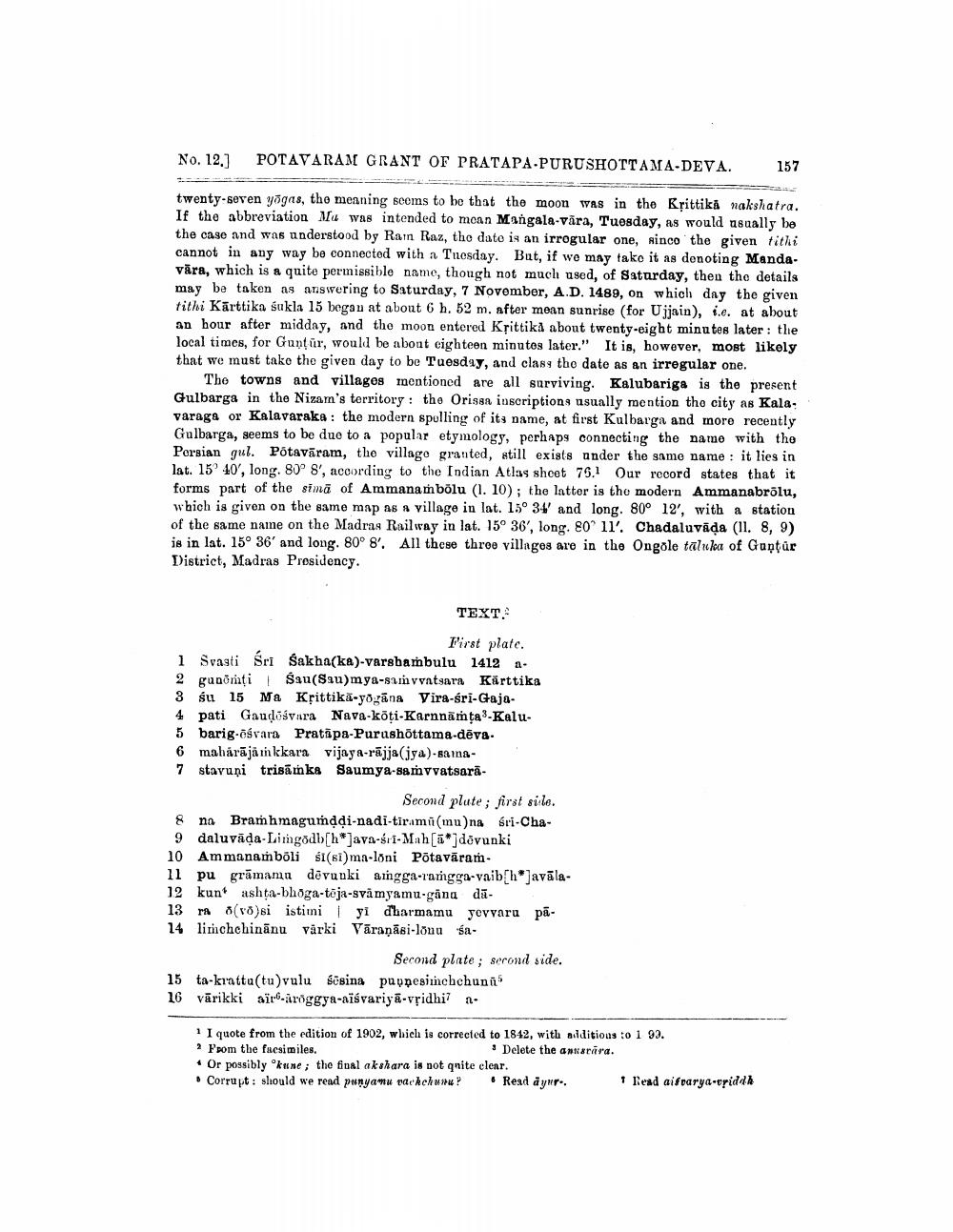________________
No. 12.]
POTAVARAM GRANT OF PRATAPA-PURUSHOTTAMA-DEVA.
twenty-seven yogas, the meaning seems to be that the moon was in the Krittikä nakshatra. If the abbreviation Ma was intended to mean Mangala-vara, Tuesday, as would usually be the case and was understood by Ram Raz, the date is an irrogular one, since the given tithi cannot in any way be connected with a Tuesday. But, if we may take it as denoting Mandavāra, which is a quite permissible name, though not much used, of Saturday, then the details may be taken as answering to Saturday, 7 November, A.D. 1489, on which day the given tithi Karttika sukla 15 began at about 6 h. 52 m. after mean sunrise (for Ujjain), i.e. at about an hour after midday, and the moon entered Krittika about twenty-eight minutes later: the local times, for Guntur, would be about eighteen minutes later." It is, however, most likely that we must take the given day to be Tuesday, and class the date as an irregular one.
The towns and villages mentioned are all surviving. Kalubariga is the present Gulbarga in the Nizam's territory: the Orissa inscriptions usually mention the city as Kalavaraga or Kalavaraka: the modern spelling of its name, at first Kulbarga and more recently Gulbarga, seems to be due to a popular etymology, perhaps connecting the name with the Persian gul. Potavāram, the village granted, still exists under the same name: it lies in lat. 15° 40', long. 80° 8', according to the Indian Atlas sheet 75.1 Our record states that it forms part of the sima of Ammanam bolu (1. 10); the latter is the modern Ammanabrōlu, which is given on the same map as a village in lat. 15° 34' and long. 80° 12', with a station of the same name on the Madras Railway in lat. 15° 36', long. 80' 11'. Chadaluvada (11. 8, 9) is in lat. 15° 36' and long. 80° 8'. All these three villages are in the Ongole taluka of Guntur District, Madras Presidency.
TEXT First plate.
a
1 Svasti Śrī Sakha(ka)-varshambulu 1412 2 gunomți Sau(Sau)mya-samvvatsara Kärttika 3 su 15 Ma Krittikä-yogana Vira-sri-Gaja4 pati Gaudosvara Nava-kōṭi-Karnnāmţa3-Kalu
5 barig-ośvara Pratapa-Purushottama-dēva.
6 maharajakkara vijaya-rajja(jya)-sama
7 stavuņi trisamka Saumya-samvvatsara
Second plate; first side.
8 na Bramhmagumḍḍi-nadi-tiram (mu) na śri-Cha9 daluvada-Lingodb [h]ava-sri-Mah[*]dovunki
10 Ammanambōli si(si)ma-loni Pōtavāram
11 pu grāmamu dēvunki aingga-ramgga-vaib[h*]avala
12 kun ashta-bhoga-tēja-svamyamu-gānu da
13 ra (vo)si istimi yi dharmamu yevvaru pā14 limchchinanu vārki Varanasi-lonu sa
Second plate; second side.
15 ta-krattu(tu)vulu sesina puppesimchchunn 16 vārikki air-aroggya-aïsvariya-vridhi a
1 I quote from the edition of 1902, which is corrected to 1842, with additions to 1 99.
2 From the facsimiles.
Delete the anusrara.
Or possibly kune; the final akshara is not quite clear. Corrupt: should we read punyamu vachchunu?
Read ayur..
157
Read aifvarya-vriddh




